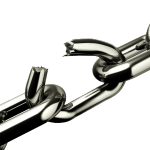 This article is part of a series on Lean and the Theory of Constraints. Here is the 3 part series:
This article is part of a series on Lean and the Theory of Constraints. Here is the 3 part series:
- Lean and Theory of Constraints: An Either/Or Proposition?
- The Theory of Constraints – The Fundamentals
- Reconciling Lean and The Theory of Constraints
I’m not a fan of dichotomous thinking – either / or.
For one, it’s formally a psychological disorder and, two, it’s neither practical nor true. As with most things in life, there is usually at least a third choice – in fact, there are many more choices, realistically.
So, when voices – loud voices – claim their business philosophy is better than such and such, I have to step back and evaluate: Isn’t there an alternative? Instead of “or”, isn’t there an “and”?
This is true for Lean Thinking, Six Sigma, Systems Thinking, and Theory of Constraints. Arguing which is better is a waste of time. The pragmatic approach is that there is good in all of them. Take what works, apply it appropriately for your business, and if the results are good and the approach was humane and good, then roll with it.
In this series on Lean and The Theory of Constraints, I’ll attempt at reconciling the two business philosophies and show how they can work together and help improve the organization.
History
The Theory of Constraints first emerged from Dr. Eliyahu Goldratt’s popular book “The Goal“. That book is now required reading in most business courses because it reads easily: it’s a business novel, but embedded in the novel is a strong message about constraints or bottlenecks and their impact on a business.
Lean Thinking was popularized by Womack and Jones in their landmark book “The Machine that Changed the World.” The term “Lean” was coined by a Bob Hartman, an MIT researcher who used that word to describe how Toyota did “everything with half of everything” – half the people, half the budget, half the space, with fewer quality problems and delivered in half the time than its competitors.
In the next section, I’ll highlight the fundamentals of Lean Thinking and The Theory of Constraints.








I tend to dismiss experts who zealously espouse their particular method(s) over another. I agree that there is good to be found in most of the modern continuous improvement methodologies and it behooves one to know them well. There is still (and always will be) room for open mindedness. Each organization, system, situation is unique and therefore I believe the most important thing one can do is THINK deeply and then apply practically. Your posts always make me think so I’m very interested to see your next posts on this subject.
Most definitely, Lean & TOC (and 6Sigma) can coexist. In fact, many of us contend that the focusing aspect of TOC is quite complementary to Lean/6Sigma and helps to deliver bottom line results more quickly. Fundamentally, if the bottleneck determines the output of the system then by first identifying the bottleneck, & subordinating other activities to it, one can proceed with applying the tools of Lean/6Sigma TO the bottleneck thus exploiting it’s capability/capacity and thus, without even beginning Lean/6Sigma activities elsewhere, you can positively impact the bottom line of the company. This will help with the buy-in necessary to move forward with implementing Lean.
By following TOC, one will also identify the Next bottleneck and by the time you’ve elevated the current one with your Lean initatives, you have your next target for Lean activities. Thus the cycle becomes self-supporting.